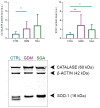Gestational Diabetes Mellitus and Small-for-Gestational-Age: An Insight into the Placental Molecular Biomarkers
- PMID: 36768564
- PMCID: PMC9916826
- DOI: 10.3390/ijms24032240
Gestational Diabetes Mellitus and Small-for-Gestational-Age: An Insight into the Placental Molecular Biomarkers
Abstract
Gestational diabetes mellitus (GDM) and small-for-gestational-age (SGA) are two metabolic-related diseases that could affect women during pregnancy. Considering that the chorionic villi (CVs) are crucial structures for the feto-maternal exchange, the alterations in their conformation have been linked to an imbalanced metabolic environment of placenta. In this study, a multidisciplinary approach has been carried out to describe the changes occurring in the placental CVs of GDM and SGA patients. The results revealed higher levels of superoxide dismutase 1 (SOD-1) and catalase (CAT), especially in the GDM placentae, which could be correlated with the hyperglycemic environment characteristic of this pathology. Furthermore, spectroscopy and histologic analyses revealed that both pathologies modify the placental lipid composition altering its structure. However, SGA induces lipid peroxidation and reduces collagen deposition within the CVs. Since the endocannabinoid system (ECS) is involved in placentation and different metabolic activities, the cannabinoid receptor 1 (CB1) and transient receptor potential cation channel subfamily V member 1 (TRPV-1) were analyzed. No changes have been observed either at general or specific levels in the CVs comparing control and pathological samples, suggesting the non-involvement of the cannabinoid system in these two pathologies.
Keywords: FTIRI; GDM; SGA; endocannabinoid receptors; placenta.
Conflict of interest statement
The authors declare no conflict of interest.
Figures









References
-
- Alia S., Pugnaloni S., Borroni F., Mazzanti L., Giannubilo S.R., Ciavattini A., Vignini A. Impact of gestational diabetes mellitus in maternal and fetal health: An update. Diabetes Updates. 2019;5:1–6. doi: 10.15761/DU.1000129. - DOI
MeSH terms
Substances
Grants and funding
LinkOut - more resources
Full Text Sources
Miscellaneous

